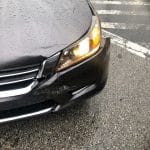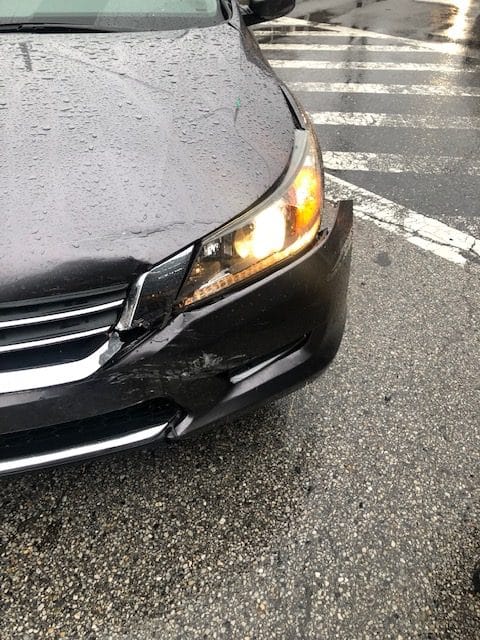After winning a trial last week and helping obtain a recovery for my client in his auto accident, I can say, for a fact, that we won the case with one single photo (the case was 5 years old, so it was one that my client forgot he even took). This was a bench trial in District Court, so it was not a huge case by judicial standards, but it was a huge case for my client and his family.

This photo shows the defendant’s vehicle at an angle compared to the crosswalk. The Defendant testified that he was pointed straight and this photo directly contradicted his testimony.
When the Judge announced the ruling in my client’s favor, he specifically pointed to the one photo that I highlighted in closing argument as his basis for ruling that the accident was the defendant’s fault and that my client was not contributorily negligent or at fault whatsoever. He actually said that the photo showing the final position of the vehicles was what cemented liability in our client’s favor – and didn’t make sense compared to the defendant’s story. One single photo.
I wanted to write a blog post regarding an often overlooked thing during an auto accidents: good photos of the crash. They say that a picture is worth a thousand words and in the case of an auto accident, maybe thousands of dollars.
When involved in a car crash, emotions run high, you could be seriously injured, and it’s easy to feel overwhelmed. However, amidst the chaos, one often overlooked but essential aspect is the importance of capturing high-quality photos at the scene of the accident. In this blog post, we’ll explore why taking good photos is crucial for auto accident cases and how it can significantly impact the resolution of your auto accident.
- Preserving Evidence: One of the primary reasons for taking quality photos after an auto accident is to preserve crucial evidence. Pictures of the scene, vehicle damage, road conditions, and any relevant surroundings provide a visual record that can be invaluable later on. This evidence can be pivotal in establishing fault and determining the extent of damages. Tip:Start far away, take multiple photos, and get up close as you work around a scene – just like a crime scene photographer! Many people take only photos of the damages to their cars, but take pictures of everything! Let the lawyer sort it out.
- Documenting Injuries: In addition to capturing the scene and vehicular damage, it’s essential to document any injuries sustained by those involved in the accident. Photos can serve as a visual record of the immediate aftermath, which can be vital for medical experts, adjusters, and lawyers (and jurors) when assessing the extent of injuries and their impact on the victims’ lives.
- Establishing Fault: Quality photos play a significant role in establishing fault in auto accident cases. Clear images of the accident scene, skid marks, traffic signals, and any relevant road signs help recreate the sequence of events leading to the collision. This visual evidence can be instrumental in proving or disproving liability, ultimately influencing the outcome of settlement or a judge or jury trial.
- Assisting Insurance Claims: When filing an insurance claim, thorough documentation is key. High-quality photos provide insurers with a clear and comprehensive understanding of the accident, helping to expedite the claims process. Insurance adjusters can use these visuals to assess damages, determine liability, and process claims more efficiently.
- Strengthening Legal Cases: In the event of a legal dispute, well-documented photos can be a powerful tool for attorneys. The visual evidence can strengthen a legal case by providing a clear representation of the damages, potentially influencing the decision in favor of our client. Like in my story above, courts often rely on visual evidence to support or challenge witness testimonies, making photos a crucial element in the legal proceedings.
In the aftermath of an auto accident, the importance of taking good photos cannot be overstated. These visual records serve as an extra, independent witness, providing a clear and unbiased account of the incident. Whether you’re dealing with pre-suit settlement or court, the power of a well-documented visual narrative can make a significant difference in establishing your case but also bolstering your potential recovery! So, the next time you find yourself involved in a car crash, please try to remember to prioritize the capture of quality photos – your case might depend on it! If you find yourself the victim of another’s negligence, contact us for help!

